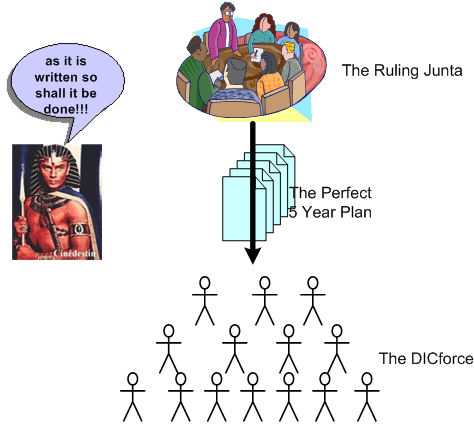Archive
The Creation Of A New Class
In the context of complex decisions with uncertain outcomes and no obvious right answer, the managerial mind inevitably longs for some handrails to grasp amid the smoke and flames. Strategic planning offers that consolation— or illusion— of a sure path to the future – Stewart, Matthew
In “The Management Myth“, Matthew Stewart researches how the business of “Business Strategy” got started and how it evolved over the decades. He (dis)credits Igor Ansoff with starting the phantom fad founded on “nonfalsifiable tautologies, generic reminders, and pompous maxims“. Mr. Stewart also credits mainstream strategy guru Michael Porter with growing the beast in the nineties into the mega-business it is today.
Perhaps the most interesting outcome from the rise of the business of strategy was the stratification of “management” into two classes, top management and middle management:
Top management takes responsibility for deciding on the mix of businesses a corporation ought to pursue and for judging the performance of business unit managers. Middle management is said to be responsible for the execution of activities within specific lines of business. This division within management has created a new and problematic social reality. In earlier times, there was one management and there was one labor, and telling the two apart was a fairly simple matter of looking at the clothes they wore. The rise of middle management has resulted in the emergence of a large group of individuals who technically count as managers and sartorially look the part but nonetheless live very far down the elevator shaft from the people who actually have power – Stewart, Matthew
I always wondered how the delineation between “top” and “middle” management came about. Now I know why.
Transparency, Meritocracy, and Collaboration
When Red Hat Inc. went public with much fanfare 12 years ago, I thought there was no way the company would make money on the Linux open source operating system. As usual, BD00 was outright wrong. This MIX article by Red Hat VP Jackie Yeaney, “Democratizing the Corporate Strategy Process at Red Hat”, may explain one reason why.
In her article, Ms. Yeaney shares all the details of the company’s strategic development process along with some performance metrics that demonstrate its effectiveness. Here are some snippets that I found refreshingly interesting.
“When I first started working with Red Hat at the beginning of 2008, it was readily apparent that the traditional corporate strategy development process would simply not work in an open source company where transparency, meritocracy, and collaboration were prized elements of the culture.”
“While many might view it is as a disadvantage or a time sink to systematically gather feedback from across the company, at Red Hat it’s a core part of our competitive advantage.”
“We built an internal wiki that leaders of each exploration team used to organize their thoughts and ideas out in the open where any employee could make comments or suggestions. Anyone who was particularly interested could read about the progress, and add their ideas or volunteer to help (and many did).”
“This information-gathering dialog lasted about 5 months. We communicated our progress along the way through regular updates at company meetings, through email, and on the Intranet. The strategy team leaders posted status updates to the wiki and replied to comments on their team’s internal blog. Jim hosted a company-wide online chat session where associates could ask him any question they wanted to about the strategy process (or anything else that was on their minds), and team leads communicated key updates through company-wide announcements and discussions.”
The likelihood that you have any clue of how business strategy is created in your org is low. The likelihood that you’re given the chance to actively participate in the process is even lower, dontcha think? Instead of being “engaged with” you’re simply “communicated to“, no?
Central Planning
The most visibly confirming event that showcased the fact that “central planning” doesn’t work was the demise of the former Soviet Union. The 5 year plans foisted down on the populace by the politburo big-wigs stifled creativity, innovation, and motivation. In spite of the impeccable planning by those “who knew better“, the country imploded.
Likewise, in corpocracies that are incapable of learning from the past (no matter how compelling the evidence), the same fate awaits. By the time the perfectly infallible strategies and plans from the corpo junta get approved, poured in concrete, and trickled down to the DICforce at rock bottom, they’re mostly useless and obsolete.
So, what’s a better way? How about generating flexible, multi-year rolling plans that are revisited often? Ricardo Semler uses that method at Semco. How about exposing the plans to the DICforce as they are being developed in real-time so that some insights from a larger pool of brains may be elicited? Got any other ideas?



